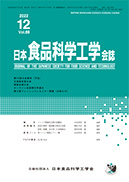
- |<
- <
- 1
- >
- >|
-
Yoshifumi Yamaya, Masashi Hosokawa, Kazuo Miyashita2022 Volume 69 Issue 12 Pages 549-555
Published: December 15, 2022
Released on J-STAGE: December 15, 2022
JOURNAL FREE ACCESSAntioxidant activities of garlic extracts and garlic compounds were evaluated by the 1,1-diphenyl-2-picryl hydrazyl radical scavenging method. In water-soluble sulfur compounds, alliin and γ-glutamyl-S-(E)-1-propenyl cysteine showed high radical scavenging activity. Garlic extracts that contained cycloalliin showed advanced browning and high radical scavenging activity. In oil-soluble sulfur compounds, allicin and 2-vinyl-4H-1,3-dithiin showed high radical scavenging activity. Oil-soluble sulfur compounds that contained allicin were added to fish oil, and were incubated at 50°C. After 24 hours, the peroxide value was less than 12 meq/kg, indicating that allicin inhibited fish oil oxidation.
View full abstractDownload PDF (594K)
-
Kounosuke Suzuri, Shinichi Murayama, Tomoko Itou, Hironobu Itou, Youic ...2022 Volume 69 Issue 12 Pages 557-564
Published: December 15, 2022
Released on J-STAGE: December 15, 2022
JOURNAL FREE ACCESSThe Standard Tables of Food Composition in Japan (FCTJ) is the only official database on food ingredients in Japan. Analyses are performed according to the methods listed in the FCTJ manual. However, there are still adverse effects on the environment and worker health when using the method that requires chloroform. In this report, we examined methyl esterification and extraction methods to establish suitable lipid and fatty acid analytical methods that are friendly to the environment and protect worker health. The results were as follows: There is no difference between the methyl esterification method in which hexane is not added to the heating solution and the current method in the FCTJ manual. The method that uses chloroform was successfully replaced with the chloroform-free method in the lipid analysis of eggs and fatty acid analysis of the five food groups. On the other hand, it was found that chloroform should only be used in lipid analysis of soy.
View full abstractDownload PDF (495K) -
Ryoga Nishimura, Hiroyuki Nakamoto, Futoshi Kobayashi2022 Volume 69 Issue 12 Pages 565-572
Published: December 15, 2022
Released on J-STAGE: December 15, 2022
JOURNAL FREE ACCESSHumans perceive mainly three stimuli when masticating food: taste, aroma, and texture. Food texture is a physical factor and has a significant impact on the palatability of food. Since good food texture contributes to the sales of food, food companies require a method to qualitatively evaluate and develop food texture. This study proposes using force, vibration, and sound to evaluate food texture. The measurement system used in this study consists of a magnetic food texture sensor and a microphone, which are used to measure force, vibration, and sound data simultaneously. Feature values are calculated from the measurement data. The Gaussian process regression was used to clarify the relationship between feature values and sensory evaluation values. In an experiment, if the sound data included unique feature values of a food sample, then the use of force, vibration, and sound more accurately estimated food texture than force and vibration alone.
View full abstractDownload PDF (864K)
-
Yoshifumi Yamaya, Noriyuki Notoya2022 Volume 69 Issue 12 Pages 573-578
Published: December 15, 2022
Released on J-STAGE: December 15, 2022
JOURNAL FREE ACCESSBlack garlic is one of the processed foods of garlic (Allium sativum). In order to improve the biologically functional quality of black garlic, the effects of raw garlic storage periods and processing temperatures on three amino acids, S-allyl-L-cysteine (SAC), cycloalliin (CA) and γ-aminobutyric acid (GABA), were analyzed.
The contents of SAC, CA and GABA in garlic cloves were increased in the early stage of heating process. In the subsequent stage, the contents of SAC and GABA were decreased, while there was no significant change in CA content.
View full abstractDownload PDF (435K)
- |<
- <
- 1
- >
- >|